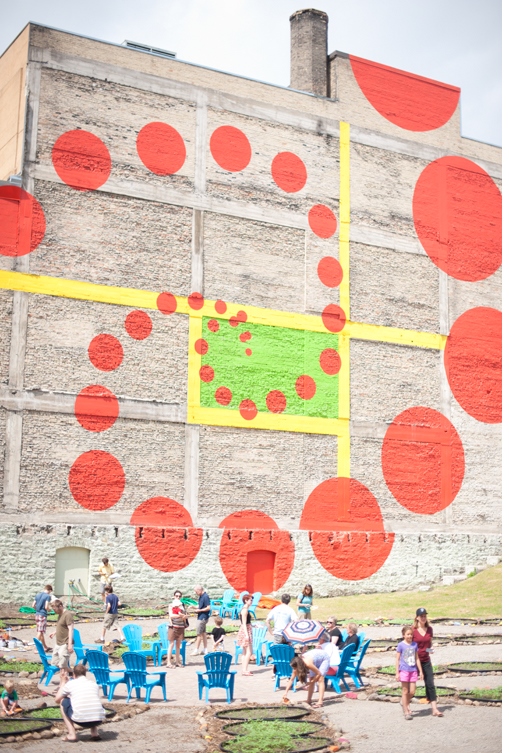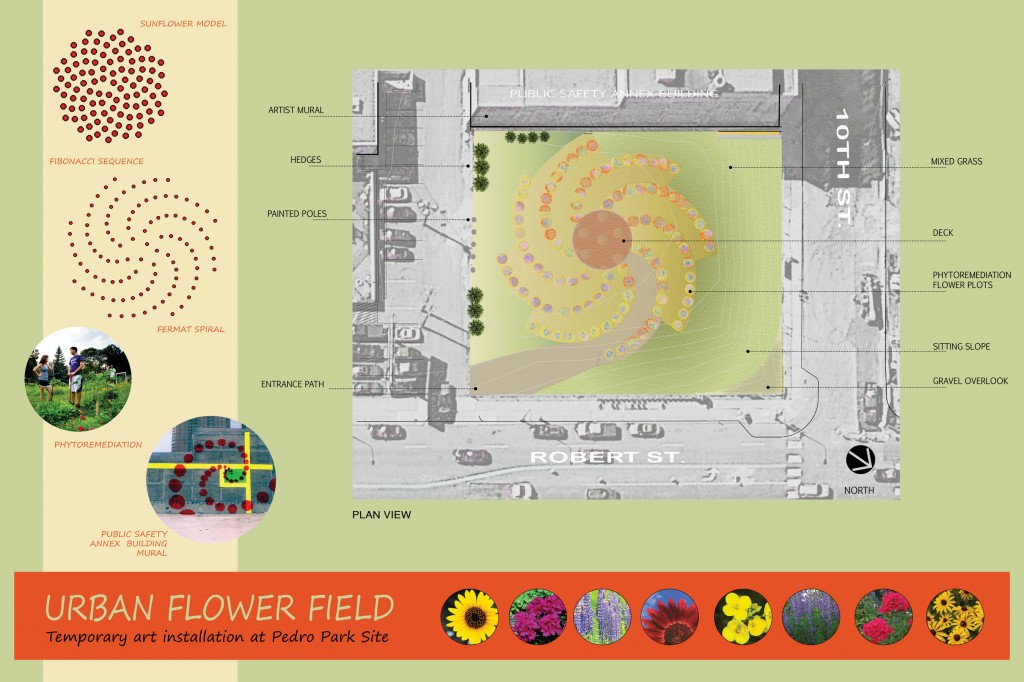
Revitalizing a neighborhood from the ground up with an Urban Flower Field
Urban Flower Field and mural, at the opening celebration June 28, 2014. Photo: Tiffany Bolk
Live in the middle of a city, and you can’t escape the cyclical flux of abandonment, demolition and development. Businesses come and go. A once-prosperous neighborhood hits hard times, and slowly dilapidating properties bear witness to its residents’ struggles. But the truth is, in an urban center, space is precious – even derelict land eventually changes hands and finds new use through renovation or redevelopment. But that in-between time, the fallow period when a plot of land lies in wait for its fortunes to turn – that unremarkable emptiness leaves a persistent sore spot that leaches vitality from its surrounding neighborhood as time goes by.
And this is precisely what makes Amanda Lovelee’s Urban Flower Field so intriguing: it offers a new way of thinking about how to bring civic and aesthetic good from such land-in-transition. There’s a vacant lot in downtown St. Paul on the corner of 10th and Robert, home for years to a family business, Pedro’s Luggage. After their shop closed in 2008, the owners donated the land to the city on the condition that it be turned into a park. And indeed, the City of St. Paul has plans in the works to turn the site into a permanent civic green space, Pedro Park. In the meantime, they’ve turned the spot over to Lovelee, one of St. Paul’s City Artists in Residence. She’s spearheaded a transformation of the lot into a temporary, living art installation. The resulting work is a collaborative exercise in public art-making, a flower garden and a civic gathering spot; it’s also an experiment in soil restoration.
The project’s sponsoring organization, Public Art Saint Paul, describes the Urban Flower Field as “a cross pollination between art, the civic process, a community, and science.” Working with University of St. Thomas director of environmental science, Adam Kay, Lovelee wanted to design the garden to be not only beautiful, but in such a way that its plantings might help revitalize the depleted soil underneath.
Urban Flower Field Concept and Design. Courtesy of the City of St. Paul website
They settled on a design nicely suited to the art-meets-science sensibility of the project, arranging the plantings in the lot according to the golden ratio of the Fibonacci Sequence. It’s a mathematic pattern that turns up repeatedly in both art and nature: in the growth of leaves around a stem, say, or the concentric spirals of seeds in a sunflower head.
Photo: Tiffany Bolk
In a recent interview with Minnesota Public Radio, Lovelee describes the project:
“I thought this was a great point to focus one [sic] because it was that moment where science meets beauty,” said Lovelee. “So I asked Adam [Kay] if the flowers needed to be planted in square plots and luckily he said no. After that the design literally spread off the ground and up the wall with the help of mural artist Ed Charbonneau and Jeremy Szopinski.”
With the help of neighborhood volunteers, the garden was planted – the Urban Flower Field officially celebrated its opening on June 28. You can see the newly commissioned mural, also rendered according to the spirals of the Fibonacci Sequence, in the top photo above.
St. Paul City Artist in Residence, Amanda Lovelee, painting field stones at the new community garden space. Photo: Tiffany Bolk
If you’d like to hear more about the project, tonight’s a good time to see it for yourself. There’s a Happy Flower Hour scheduled at the Urban Flower Field Wednesday, July 16 from 4 p.m. to 7 p.m. Stay for a glass of lemonade and listen to the evening’s art-and-science talk, co-presented by City Art Collaboratory, biology students from University of Saint Thomas and art students from Minneapolis College of Art and Design.
For more information on the project and related upcoming events and programs, visit the website at www.publicartstpaul.com/urban.
Recent Content
-
Artsarticle ·
-
Artsarticle ·
-
Artsarticle ·



